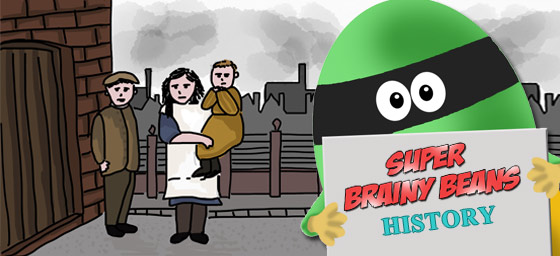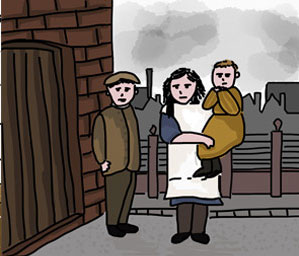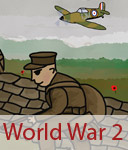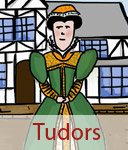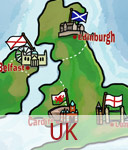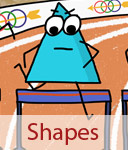Queen Victoria & Victorian children
Queen Victoria & Victorian children living in Victorian times. Facts and information for kids learning KS2 at Primary School. Homework help about the history of the Victorians, Victorian children and Victorian life.
Time: 1839 - 1901
Who were the Victorians?
The Victorians were the people who lived in Britain during the reign of Queen Victoria. She ruled from 1837 until 1901, a period of sixty-four years. During this time, Britain changed faster than it ever had before. Towns and cities grew huge as thousands of people moved from the countryside to find work. Railways spread across the country, letting people travel long distances for the first time. New machines filled noisy factories and helped produce clothes, iron, steel and many other goods.
For some people, these changes brought new opportunities and a better life. For others, especially the poor, life was extremely difficult. Many families lived in crowded homes, worked long hours and struggled to afford food and clothes. Victorian times were full of amazing inventions and clever ideas, but also great hardship and unfairness.
Queen Victoria
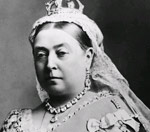
Queen Victoria is one of the most famous queens in British history. She became queen in 1837 when she was just eighteen years old. At the time, many people worried she was too young, but she proved them wrong. She went on to rule for sixty-four years, making hers one of the longest reigns ever.
In 1840, Victoria married her cousin Prince Albert, and they were very much in love. Together, they had nine children who later married into royal families all across Europe. Victoria and Albert helped shape many traditions we still enjoy today. Albert loved celebrating Christmas, especially with a decorated tree covered in candles. Because of him, Christmas trees became popular in homes all over Britain. The Victorians also invented the first Christmas card in 1843, and Queen Victoria was one of the first people to send them.
Victoria and Albert enjoyed family life and often spent holidays at Osborne House on the Isle of Wight, which Albert designed himself, and at Balmoral Castle in Scotland. These places reminded them of a peaceful family home, far away from the busy life of London.
In 1861, tragedy struck when Prince Albert died suddenly. Queen Victoria was heartbroken. In Victorian times, it was normal to wear black when someone died, but usually only for a short time. Victoria was so upset that she wore black for the rest of her life — forty years. She spent much of her time away from the public, but people still admired and respected her.
Queen Victoria died on 22nd January 1901. Her death marked the end of the Victorian era, a time of huge change in Britain.
 Queen Victoria Quiz
Queen Victoria QuizTake this quiz and find out how much you really know about Queen Victoria.
 Osbourne House
Osbourne HouseGet an unforgettable glimpse into the private family life of Queen Victoria and Prince Albert at Osborne on the Isle of Wight. From sumptuous interiors and art collections inside, to a peaceful beach and marvellous gardens outside, a day out at Osborne has something for everyone.
 Balmoral Castle
Balmoral CastleNestled in the heart of the Scottish Highlands, Balmoral has been the cherished home of the British Royal Family since 1852, offering visitors a unique glimpse into royal life surrounded by breath-taking Highland landscapes.
Life in Victorian Britain?
Life in Victorian Britain was very different depending on whether you were rich or poor. The country was changing fast. Factories sprang up all over towns, making clothes, steel, and other goods. Factory owners became very rich and lived in grand houses with many rooms, gardens, and servants. The workers who made the goods earned very little and lived in tiny, overcrowded houses in dirty areas called slums.
The streets in Victorian towns were crowded, noisy, and often very smelly. Rubbish was thrown in the streets and people sometimes used the same water for drinking and washing. Disease spread quickly, and illnesses like cholera and typhoid were common.
Most people worked long hours, often from early morning until late at night, six days a week. Families cooked on coal or wood fires, which made the kitchens smoky and warm. Washing clothes was a huge job that could take the entire day, because there were no washing machines or tumble dryers.
- In some slums, one toilet might be shared by twenty families, and people sometimes threw human waste straight into the streets.
- Rich Victorian families had special servants whose only job was to clean the shoes of the household, while poor children often had to sweep streets or work in factories to help their families survive.
Rich Victorian children
Rich Victorian children lived very comfortable lives compared to poor children. They had soft beds, warm clothes, and servants to look after them. Most of their needs were taken care of, and they rarely had to do chores.
Many rich children were educated at home by a private teacher called a tutor. Boys sometimes went to expensive boarding schools where they learned subjects like Latin, mathematics, history, and science. Girls were often taught arts and skills thought suitable for young ladies, such as painting, sewing, music, and sometimes dancing.
Rich families could afford large houses with many rooms. Children usually had their own room called a nursery, which was looked after by a nanny. The nanny often took them for walks in parks or trips to the zoo.
Rich Victorian children had plenty of beautiful toys to play with. Indoors, they enjoyed wooden dolls, porcelain dolls, tin soldiers, marbles, spinning tops and even detailed toy theatres. Some wealthy families bought their children model trains or large rocking horses that looked almost real. Outdoors, they played hopscotch, skipping games and rolled wooden hoops with a stick. Their toys were often made from wood, metal or porcelain and were carefully crafted, making them treasured possessions.
Food was plentiful and varied. They ate bread, cheese, fruit, meat, and cakes. Special treats like chocolate or jam were sometimes saved for birthdays or holidays.
- Some wealthy children had “pet monkeys” or exotic animals in their homes, which sometimes got sick or caused messes that servants had to clean up.
- One popular Victorian game was called “Snapdragon.” Children had to grab raisins from a bowl of burning brandy before their fingers got burned.
Poor Victorian children
Poor Victorian children had very hard lives. They usually lived in tiny houses in crowded streets called slums. Their homes had no inside toilets or running water, and the walls were often damp and dirty. Diseases spread quickly in these conditions, and the air was thick with smoke from nearby factories.
Many children had very few luxuries. They had to work long hours to help their families survive and often ate simple, poor-quality food like bread, porridge, and cabbage. Because they were so poor, some children resorted to stealing food or money just to stay alive.
Poor Victorian children had almost no toys, so they had to make their own fun. Many created simple toys from scraps of wood, cloth or old buttons. They played outside in the streets, climbing trees, rolling hoops made from old barrels, or inventing games with sticks and stones. Some paddled in streams or played tag when they had the energy. But life was so hard that many poor children were often too tired, sick or hungry to play at all.
Work was a big part of life for poor children. Some worked in factories, mills, or coal mines. Others cleaned chimneys, delivered goods, or worked as street sellers. These jobs were dangerous, dirty, and exhausting, and children could get badly hurt or even die.
Education was often impossible until new laws in the late 1800s required children to go to school. Many children shared tiny rooms with their families, had little food, and could not rest properly.
 Hands on History - Victorian toys and games
Hands on History - Victorian toys and gamesThere was no TV, no central heating, no cars and many children went to work, not to school. See what toys and games they played with when they had free time.
 Victorian Children
Victorian ChildrenA look at how they lived, played, worked and survived. Life for Victorian children in Victorian times was nothing like childhood in today's world.
Victorian schools
At the start of the Victorian era, most children only went to school if their parents could pay. School was not free, and many poor children never went at all. By the late 1800s, new laws meant that children had to go to school until the age of 12, and it was free for everyone.
School life in Victorian times was very strict. Teachers expected complete obedience and could be very harsh. Children sat in rows, copying lessons from the blackboard and chanting facts out loud. Boys and girls were usually taught separately, and lessons could be long and boring.
Punishments were common. Teachers often used wooden rulers or canes to hit children if they made mistakes or misbehaved. Some children were even locked in cupboards or made to stand in corners as punishment.
The lessons were mostly reading, writing, and arithmetic. Children practised handwriting using ink pens and inkwells, which often spilled and made a huge mess. They had to write neatly or face punishment. Some schools even used “slates”, small chalk boards, which could be erased and reused.
- Some classrooms were so crowded and poorly cleaned that children sometimes shared lice, fleas, or bugs with their classmates.
- If children wrote with their left hand the teacher often tied it behind their back because they believed the right hand was the only proper hand to write with.
 Victorian School
Victorian SchoolDid you know Victorian schools were grim places with windows high up so that children could not see out and classes as huge as 300 children!
Victorian jobs and working life
During the Victorian era, Britain was full of factories and workshops. Men, women, and even children worked long, exhausting hours from early morning until late at night. There were coal mines, mills, steelworks, and textile factories producing cloth, clothing, and other goods. Many people also worked as servants in rich households, builders on construction sites, cooks in kitchens, farmers in the countryside, or street sellers selling food, newspapers, or trinkets.
Working conditions were often harsh and dangerous. Factories were noisy, hot, and filled with heavy machines that could crush hands or fingers. Miners worked underground in darkness, breathing in coal dust that could make them very ill. Steelworks were filled with molten metal and fire, while textile mills had fast-moving looms and sharp scissors. Accidents happened frequently, and there were very few safety rules to protect workers.
Children were especially at risk. In factories and mines, they were often given the hardest and most dangerous jobs. Some children had to crawl under machines to fix them, carry heavy loads, or sweep up in rooms filled with smoke and dust. People worked extremely long hours, sometimes 12 to 16 hours a day, six days a week, and there were few breaks for food or rest. Poor families relied on every member, including young children, to earn money just to survive.
Workhouses
For people who could not work or had no money, life could be even harsher. They had to live in places called workhouses. These were like prisons, and once inside it was very hard to leave. Families were split up, with men, women, and children separated, and everyone had to work for their food and bed. Workhouse tasks included breaking rocks, washing clothes, and picking apart old ropes. Conditions were strict, and life was extremely uncomfortable.
Workers in factories and mines began to fight for better treatment. They formed trade unions, groups of workers who worked together to demand safer working conditions, better pay, and shorter hours. If workers were unhappy, they could protest by stopping work, known as going on strike, to make their voices heard.
 Victorians.co.uk
Victorians.co.uk A one-stop learning resource for all things Victorian! On this site, you will find information spanning over all topics and fun-filled facts about this important era in history.
 Beamish Open Air Museum - County Durham, UK
Beamish Open Air Museum - County Durham, UK Beamish is a world famous open-air museum. We tell the story of life in North East England in leading up to the First World War.
Victorian homes
In Victorian Britain, life at home was very different depending on whether you were rich or poor.
Rich Victorian homes
Wealthy families lived in large, impressive houses with many rooms. They had fireplaces in nearly every room to keep warm, fancy furniture, soft carpets, and gas lamps to light their homes at night. Big dining rooms were used for formal meals, and some houses even had libraries, music rooms, and private gardens. Servants did most of the hard work — cooking, cleaning, washing clothes, and looking after the children. Rich children often had their own bedrooms and toys to play with, such as dolls, miniature furniture, and wooden trains.
Poor Victorian homes
Poor families lived in tiny, crowded houses called slums. Sometimes a whole family slept in just one room, with children sharing a single bed. The rooms were often damp, dark, and cold, and there were no proper bathrooms. In some poor neighbourhoods, twenty families might share the same toilet. Water had to be fetched from a street pump, and toilets were shared with several other families, which made disease easy to spread. Cooking was done on a small coal or wood fire, and washing clothes took hours with no machines to help.
Victorian inventions
The Victorian era was full of amazing inventions that changed the way people lived, worked, and travelled.
Transport and travel
The railways spread across Britain, connecting towns and cities for the first time. People could travel much faster than before, and trains carried goods across the country. The first bicycles, called penny-farthings, had huge front wheels and tiny back wheels — they were tricky to ride and people often fell off! Early cars and steam-powered vehicles also appeared, though they were very slow compared to today.
Communication
The telephone was invented so people could speak to each other across long distances instead of relying on letters. Photography became popular too, letting families capture memories in black-and-white pictures.
Homes and everyday life
Victorians loved clever gadgets to make life easier. Flushing toilets became more common, replacing chamber pots and helping to make cities cleaner. Gas lighting brightened homes and streets, allowing people to work or walk safely after dark.
Industry and work
Steam power revolutionised factories. Machines could produce goods much faster than before, which meant more toys, clothes, and household items were available for people to buy.
What did Victorians eat?
Rich Victorians
Rich families enjoyed huge meals with many courses. Their tables were full of roast meats, fish, puddings, jellies, pies, and fresh fruit. They ate a lot of meat, including chicken, pork, venison, and even pheasant. Vegetables such as carrots, onions, turnips, and potatoes were common, but often cooked in butter or gravy to make them tastier. Tea, coffee, and chocolate drinks were popular, and meals were often followed by sweet treats like custard or sponge cakes.
Poor Victorians
Life was very different for poor families. They could not afford fancy food and often survived on bread, potatoes, milk, and cheese. Meat was a rare treat, only eaten once a week if they were lucky. Children sometimes had tea with bread and dripping, which was bread spread with melted animal fat. Gruel, a watery porridge made from oats or barley, was another common meal.
Victorian clothes
Rich Victorians
Rich people wore very formal and often uncomfortable clothing. Men wore tailored suits, waistcoats, and top hats. Women wore long dresses with multiple layers and tight corsets that could make it hard to breathe or move. They also wore gloves, hats, and carried parasols to protect themselves from the sun. Shoes were often polished and made from leather. Fashion was very important, and wearing old or worn clothes was seen as embarrassing.
Poor Victorians
Poor families wore simple, practical clothes that were patched and repaired many times. Clothes were made from cheap materials like wool or rough cotton. Because washing was hard work, most families only washed their clothes once a week, sometimes less. Shoes were often handed down between siblings.
Children’s Clothing
Children usually wore miniature versions of adult clothing. Boys wore trousers and shirts, while girls wore dresses and pinafores. Many children didn’t have special play clothes, so their clothes were often dirty and patched from rough games.
The Crimean War and Florence Nightingale
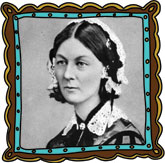
The Crimean War began in 1853 when Britain, France and Turkey fought against Russia. Russia wanted to take control of more land in Europe, and Britain feared that if Russia succeeded, they might try to take British India too. Thousands of soldiers were sent across Europe to fight, but what happened in the hospitals became just as famous as the battlefields.
The hospitals for wounded soldiers were in a terrible condition. They were cold, filthy and overcrowded. There were not enough beds, the food was rotten and many soldiers died from infections rather than their wounds. Disease spread quickly because rats ran across the floors and sewage leaked into the buildings.
Florence Nightingale, a determined and well trained nurse, travelled with a team of nurses to help. When she arrived, she was shocked by what she found. She cleaned the wards, scrubbed the floors, changed bedding and made sure clean water and fresh bandages were available. She organised the hospital properly so the soldiers were cared for instead of ignored.
At night, Florence walked through the dark corridors with an oil lamp to check on every soldier. Because of this, she became known as The Lady with the Lamp. Her work saved many lives and completely changed the way hospitals were run.
Even Queen Victoria supported the soldiers. She sent warm hats, scarves and blankets for them to wear in the freezing winter.
Florence Nightingale later helped design better hospitals in Britain and trained new nurses. Many of the rules she created are still used in hospitals today.

